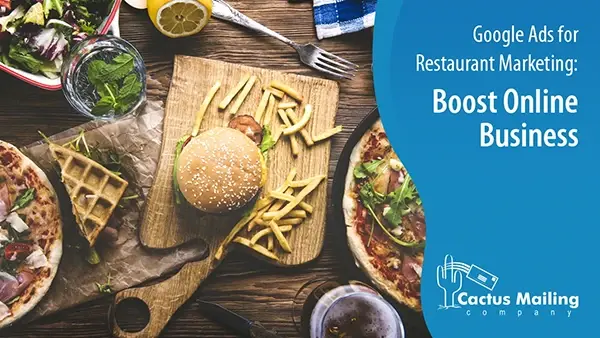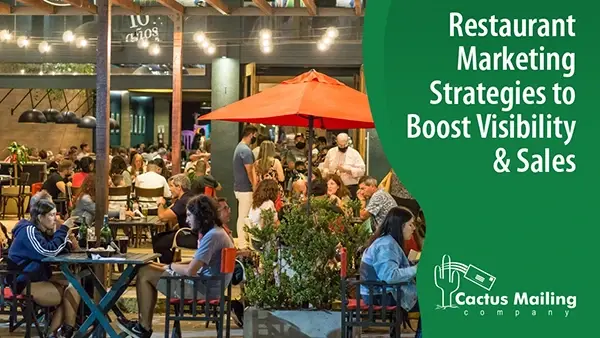We Are Here to Help!
What to Expect from Us:
No Pressure, Just Service!
Get no obligation pricing details and strategies that will work for your business.
Effective marketing is crucial for the growth and success of your restaurant in the competitive world of dining and hospitality. Google Ads has emerged as a powerful tool to boost visibility and attract more customers to your establishment. With the ability to target specific demographics, interests, and areas, these ads can help you connect with potential patrons when they're searching for dining options.
By investing in Google Ads, your restaurant can appear at the top of the search engine results, capturing the attention of people actively looking for a place to eat. The search ads platform offers a variety of ad formats and targeting options that allow you to craft a flexible and tailored marketing strategy. Whether your targeted ads aim to reach a local audience or tourists searching for a unique dining experience through Google Maps in your area, Google Ads provides the analytics and customization to make your search ads' campaigns effective and economically efficient.
Key Takeaways
- Google Ads enhances restaurant marketing by targeting potential customers effectively.
- A tailored marketing strategy via Google Ads can increase your restaurant's online visibility.
- Adapting to local search trends and optimizing campaigns can improve engagement and retention.
Understanding Google Ads and How They Work
Google Ads is a powerful tool that enables your restaurant to have relevant keywords that appear prominently when a potential customer searches online. You can make search campaigns to reach diners effectively and efficiently through search and display networks, precise keyword targeting, search and display campaigns, a refined auction system and responsive ads.
Search Network: This is where your ads can appear alongside other search engine results when someone is looking for restaurants like yours. The Search Network targets users' intent, displaying your ad in response to search queries.
Display Network: Contrarily to Google display ads, the Display Network places your restaurant ads up on many websites across the internet, not limited to Google search results. You can include banner ads on blogs and news sites, giving your restaurant ads more visual exposure in a more passive browsing context.
Keywords and Match Types
Selecting the right keywords to create ads is critical for campaign success. These are terms a potential customer uses to search for dining options. There are different keyword match types you can use to control who sees your ad:
- Exact Match: Target searches that match your keyword precisely.
- Phrase Match: Captures searches including your keyword in the exact order, with possible additional words before or after.
- Broad Match: Covers a wide range of search terms related to your keyword, including synonyms and related searches.
- Negative Keywords: Help you exclude terms that aren't a good match for your restaurant, saving your budget from irrelevant clicks.
Bidding, Auction, and Campaign Type
As a restaurant owner, when you run ads in a Google Ad campaign, you enter a bidding process in which you set a maximum bid amount you're willing to pay for a click on your ad. The Google ad auction determines which ads will appear for a given keyword phrase or search query, mainly based on bid amount and ad quality.
- Campaign Type is another consideration in determining where and when your ad will show. You can choose from several types of ad campaigns:
- Search Campaigns for text-based ads on search results pages.
- Display Campaigns for image-based ads on websites within the Google Display Network.
- Shopping Campaigns for product listings on Google.
- Video Campaigns for ads on YouTube and other video platforms.

Your bidding strategy and campaign type should align with your restaurant marketing goals—whether that’s increasing visibility, driving traffic to your website, or promoting a new menu.
Crafting Your Restaurant Marketing Strategy
When developing your restaurant marketing strategy, understanding your clientele and setting definite goals within a specific budget is paramount.
Identifying Your Target Audience
Your target audience is the backbone of your marketing strategy. To identify your audience, consider your restaurant's concept, location, and potential customers' preferences. Are you catering to busy professionals, families, or health-conscious diners? Understanding demographics helps tailor your Google Ads campaigns effectively, ensuring you reach the right individuals with preferences aligning with your offerings.
Setting Clear Goals and Budget
For your marketing budget, it’s essential to establish clear goals. Ask yourself what you aim to achieve with your campaigns. Are you looking to increase foot traffic, enhance online reservations, or promote specific menu items? Once your objectives are set, allocate a budget that reflects these goals while maintaining financial sustainability. The budget should encompass various marketing channels emphasizing tracking and adjusting as needed based on performance. Remember, a well-defined budget is your roadmap to achieving the desired return on investment from your restaurant marketing efforts.
Optimizing for Local Searches
To dominate your local market, it's crucial to strategically position your landing page and pages for your restaurant in Google Search and on Google Maps. Here's how you can attract more diners by a relevant landing page and optimizing your landing page for local searches.
Importance of Google Maps and Local SEO
For any local restaurant, being easily discoverable online is not just an option—it's a necessity. A well-optimized Google My Business listing enhances your restaurant's appearance in local searches. By focusing on local SEO, you ensure that when new customers search for places to eat within your geographic area, your establishment stands out.
Leveraging Geographic Area and Location Targeting
To directly target new customers in your vicinity, use location targeting settings in Google Ads. By setting a specific geographic area, your ads will be shown predominantly to people searching for restaurants near them. Combine this with relevant, locale-specific keywords in your restaurant ad copy to increase the appeal and relevance to those in your target location. Targeting the right audience reduces unnecessary ad spend and increases your chances of converting online searches into actual foot traffic for your restaurant.

Building a Strong Online Presence
A strong online presence stands as your digital storefront and primary customer acquisition channel. Strategic development of your website and the use of social media as a marketing tool are pivotal in harnessing the advantages of online restaurant advertising.
Effective Website and Mobile Optimization
Your website serves as the central hub for your restaurant's online presence. To turn visitors into diners, ensure your website is user-friendly and mobile-friendly. A responsive design automatically adjusts mobile advertising to fit all screen sizes, essential for customers using mobile devices. Key elements include a simple, intuitive navigation and quick loading times to improve the overall user experience.
- Menus: Present your menus with clear, high-quality photos and detailed descriptions. Make sure they are easily accessible, with current items and prices.
- Contact Information: Clearly display your address and phone number for immediate actions, such as phone calls or generating directions.
- Reservations: If applicable, integrate a system for online reservations to streamline the booking process.
Utilizing Social Media Marketing
Social media platforms are powerful marketing tools that help you connect with your community and showcase your restaurant's unique personality. Create profiles on platforms where your target audience is most active and engage with them through regular, high-quality content.
- Photos and Updates: Share vivid photos of your dishes, special promotions, and behind-the-scenes glimpses to attract attention and encourage sharing.
- Customer Interaction: Use social media to respond to feedback and queries. This interaction fosters a community and can improve your restaurant's reputation.
- Promotions: Announce exclusive deals and events to encourage followers to visit your restaurant or take part in online campaigns.
By integrating an effective website with dynamic social media marketing, you create a robust online presence that captivates potential customers and encourages them to dine at your restaurant.
Types of Google Ads for Restaurants
Google Ads offers a variety of ad types to help you make multiple ads to maximize search traffic and reach potential customers. Whether you're looking to run restaurant advertising to get new customers, attract repeat visitors, promote special offers, or highlight your takeaway service, there's an ad type that can cater to your marketing needs.
Your restaurant's ads can be customized to appear during specific hours or days, aligning with your opening times or special promotions. You can schedule your ads to show when a potential customer is most likely to be searching for dining options, such as during lunch hours or over the weekend. This ensures that your paid advertising reaches your audience at the most opportune moments, maximizing the chances of conversion.
Maximizing Visibility and Engagement
To amplify your restaurant's online presence using Google Ads, focus your ad spend on strategies that elevate visibility and encourage engagement. Tailoring your ads to the user's experience through remarketing campaigns and ad extensions can lead to a measurable increase in both your click-through rate and conversion rate.
Remarketing is your tool for re-engaging potential customers who have already expressed interest in your restaurant. By establishing a remarketing campaign, you can display ads to users' mobile devices who have visited your website but did not make a reservation. This method is effective for new customers by reminding them about your restaurant, possibly enticing them to return and complete their booking.
An ad extension enriches your ads with additional information and can significantly improve your ad's performance. Use sitelink extensions in Google restaurant ads to direct customers to specific landing pages only, like your menu or specials. Incorporate call extensions into your new ad groups to allow for easy reservations. Location extensions are critical for driving foot traffic, by showing your restaurant's address right in the ad.
Attracting and Retaining Customers
Harnessing the power of Google Ads is crucial for attracting new customers and encouraging repeat visits. Your paid search ads' strategy should hinge on two pivotal elements: leveraging promotions and special offers, and amplifying your restaurant owners' online presence through reviews and brand awareness.
Promotions and special offers are your front-line tactics in the digital space to generate immediate interest and increase foot traffic. By crafting time-sensitive discounts and exclusive deals, you immerse potential diners in an irresistible call to action. While setting up your first Google Ads campaign, you can target these promotions to reach diners during peak mealtimes, which amplifies the likelihood of conversions.
- Limited-Time Offers: Create urgency with deals expiring soon to prompt quick decisions.
- Events & Group Offers: Tailor campaigns for private events and group bookings, to attract large parties.
Building Reviews and Brand Awareness
Reviews are the currency of trust in the restaurant industry, directly influencing the decision-making process of your potential patrons. A positive review profile can be your ticket to sustained growth, so it's imperative to encourage satisfied customers to share their experiences online. Integrating your own Google Ads campaigns with platforms that highlight customer testimonials can draw a direct line from a positive review to a new customer's first visit.
- Encourage Reviews Post-Dining: Use email marketing to follow up with customers, politely asking for reviews.
- Brand awareness is fostered not just through customer testimonials but also through consistent messaging across all your online platforms. Whether you're a cozy local bistro or a burgeoning franchise, establishing a recognizable brand can lead to lasting customer relationships.
- Consistent Branding: Ensure your ads are in sync with your website's look and color scheme.
- Email Marketing: Maintain an ongoing conversation with your customers, providing updates and incentives for repeat visits.
Implementing Google Ads campaigns that are focused on these areas can help connect your restaurant to prospective diners effectively, cultivating a relationship that blossoms from the first click to the first bite and beyond.
Effective Campaign Management
Effective Google Ads campaign management is crucial for the digital marketing success of your restaurant. It involves wisely allocating your budget and continually optimizing campaigns for the best ROI. This optimization includes monitoring bidding strategies, choosing between CPM for visibility or CPC, and conversion-focused approaches for patronage, with the average CPC for restaurants being around $1.84. Regular performance data analysis is key to aligning campaigns with your goals, including making bid adjustments to your paid ads based on device usage and peak times. Utilizing Google Analytics to understand user interactions and tracking conversion rates are essential to assess ad effectiveness. Conversion tracking in Google Ads helps in optimizing bids and ad spend by showing the tangible outcomes of ad clicks. Continuous adjustments using this data can significantly enhance your campaign's effectiveness, increasing visibility, engagement, and ultimately driving more customers to your restaurant.

Conclusion
Google Ads stands as an indispensable tool in the arsenal of modern restaurant marketing. Its ability to enhance visibility and attract a diverse customer base through targeted paid advertising is unparalleled in the digital marketing realm. By leveraging this platform, restaurants can gain prominence in search engine results and tailor their marketing strategies to meet specific audience needs.
Crafting impactful ad copy, setting the right budget for ad spend and optimizing ad targeting for the best results ensures that restaurants are seen by the right people at the right time.
Optimize your restaurant's Google Ads with smart budgeting and regular campaign tuning. Focus on smart bidding, monitor CPC trends, and use Google Analytics to guide adjustments. Track conversions to refine targeting and ad spend, ensuring maximum ROI and patronage.
Google Ads is an invaluable asset for growth and success in the highly competitive dining and hospitality industry.
Our direct mail postcards have helped various businesses get leads, boost awareness, and grow revenue. Let us help you create a restaurant marketing postcard design to achieve your marketing goals!

 Cactus Mail Team: Jul 03, 2024
Cactus Mail Team: Jul 03, 2024




